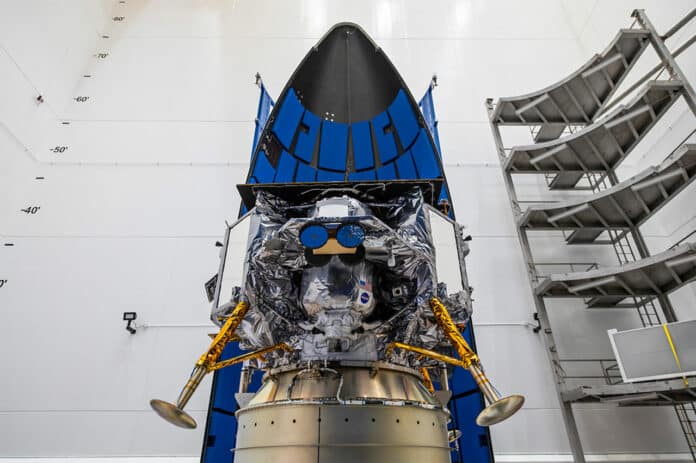Pittsburgh-based aerospace and robotics company Astrobotic announced that their Peregrine lunar lander has successfully completed all integration milestones and was successfully mated with United Launch Alliance’s Vulcan rocket payload adapter last month. After undergoing final checkouts and a 3-week fuel campaign, the Peregrine lander is scheduled to lift off no earlier than January 8, 2024, carrying NASA and commercial payloads.
Peregrine is Astrobotic’s first lander mission. The nearly two-meter tall Peregrine lander will carry 20 payloads, or cargo, including five from NASA’s Commercial Lunar Payload Services (CLPS) initiative. The lander will operate for around 192 hours after it touches down on the lunar surface, providing power and communications to the payloads.
The payload teams have a wide variety of missions that vary from seeking indications of water ice near the lunar surface to demonstrating a rover swarm. Additionally, the lander will carry several payloads representing humanity through artwork and historical artifacts.
“If you’ve been following the lunar industry, you understand landing on the Moon’s surface is incredibly difficult. With that said, our team has continuously surpassed expectations and demonstrated incredible ingenuity during flight reviews, spacecraft testing, and major hardware integrations,” says John Thornton, Astrobotic CEO. “We are ready for launch and for landing.”
The target date for the launch of Peregrine was initially set for December 24 but was rescheduled to January 8 to accommodate a wet dress rehearsal for ULA’s Vulcan Centaur rocket. The mission’s launch window is from Space Launch Complex 41 at the Cape Canaveral Space Force Station in Florida, and it is expected to pave the way for a lunar landing on February 23, 2024.
After the launch, Peregrine has a comprehensive checklist of tasks to accomplish in its journey to the Moon. The initial few tasks entail the spacecraft detaching from the rocket, powering on, and establishing communication with Earth. The telemetry data will then flow through the NASA Deep Space Network and provide the Astrobotic Mission Control Center in Pittsburgh with information about the spacecraft’s orientation, position, and overall operational condition.
Around 40 minutes after separation from ULA’s Vulcan rocket, Peregrine’s propulsion system will activate and receive commands from Astrobotic’s Mission Control Center. The first command will initiate thrusters to align Peregrine’s solar panels with the Sun to start charging its battery. During the cruise, the team will execute trajectory adjustment maneuvers in Earth orbit before lunar orbit insertion. After the orbit insertion, Peregrine will reside in a stable orbit and undergo system checkouts before attempting a historic landing.
Astrobotic is executing the mission as part of under a $79.5 million contract from NASA as part of the agency’s CLPS program. The company has also secured a second CLPS contract for its much larger Griffin lander, which is expected to launch in late 2024.
Astrobotic is one of several companies that believe there will be a thriving market for lunar payload delivery services, including Intuitive Machines, Firefly Aerospace, and ispace.
